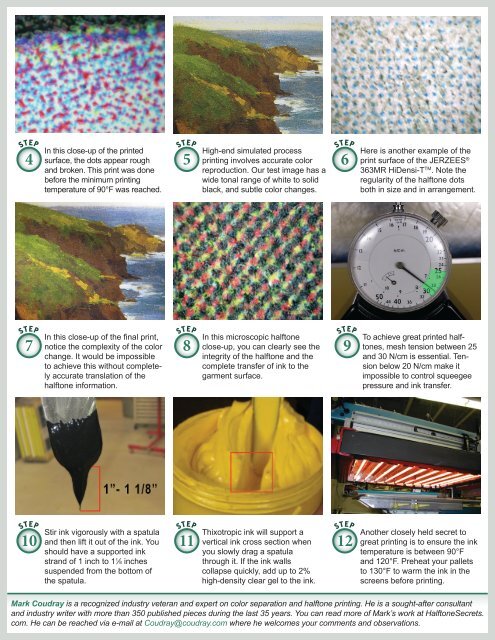Mastering High-End Simulated Process Printing - Impressions
Mastering High-End Simulated Process Printing - Impressions
Mastering High-End Simulated Process Printing - Impressions
Create successful ePaper yourself
Turn your PDF publications into a flip-book with our unique Google optimized e-Paper software.
step<br />
4<br />
step<br />
7<br />
step<br />
10<br />
In this close-up of the printed<br />
surface, the dots appear rough<br />
and broken. This print was done<br />
before the minimum printing<br />
temperature of 90°F was reached.<br />
In this close-up of the final print,<br />
notice the complexity of the color<br />
change. It would be impossible<br />
to achieve this without completely<br />
accurate translation of the<br />
halftone information.<br />
Stir ink vigorously with a spatula<br />
and then lift it out of the ink. You<br />
should have a supported ink<br />
strand of 1 inch to 1 1 ⁄8 inches<br />
suspended from the bottom of<br />
the spatula.<br />
step<br />
5<br />
step<br />
8<br />
step<br />
11<br />
<strong>High</strong>-end simulated process<br />
printing involves accurate color<br />
reproduction. Our test image has a<br />
wide tonal range of white to solid<br />
black, and subtle color changes.<br />
In this microscopic halftone<br />
close-up, you can clearly see the<br />
integrity of the halftone and the<br />
complete transfer of ink to the<br />
garment surface.<br />
Thixotropic ink will support a<br />
vertical ink cross section when<br />
you slowly drag a spatula<br />
through it. If the ink walls<br />
collapse quickly, add up to 2%<br />
high-density clear gel to the ink.<br />
step<br />
6<br />
step<br />
12<br />
Here is another example of the<br />
print surface of the JERZEES ®<br />
363MR HiDensi-T TM . Note the<br />
regularity of the halftone dots<br />
both in size and in arrangement.<br />
Another closely held secret to<br />
great printing is to ensure the ink<br />
temperature is between 90°F<br />
and 120°F. Preheat your pallets<br />
to 130°F to warm the ink in the<br />
screens before printing.<br />
Mark Coudray is a recognized industry veteran and expert on color separation and halftone printing. He is a sought-after consultant<br />
and industry writer with more than 350 published pieces during the last 35 years. You can read more of Mark’s work at HalftoneSecrets.<br />
com. He can be reached via e-mail at Coudray@coudray.com where he welcomes your comments and observations.<br />
step<br />
9<br />
To achieve great printed halftones,<br />
mesh tension between 25<br />
and 30 N/cm is essential. Tension<br />
below 20 N/cm make it<br />
impossible to control squeegee<br />
pressure and ink transfer.



